Being the stony-faced, mute creatures that they are, it can be difficult to know whether your tortoise is happy in your care. Sure, you can follow all the ‘correct’ protocols, feed them correctly and so on, but you need more than what is essential for survival in order to have a ‘thriving’ tortoise. Whilst they will never be able to explicitly show you they are happy, in the end all you can do is make sure you’ve set up your tortoise enclosure as best you can so that they have everything they need to lead a healthy and interesting existence.
There are many products on the market the purport to be ‘essential’ tortoise accessories, but of course ‘essential’ is by nature a subjective term. Here I’ll give my honest opinion about what products your tortoise really will benefit from, speaking from my own experience.
If you think I’ve left anything off, my apologies, please send me a message with your own ideas for what works well for your own tortoise!
1. Cuttlebone
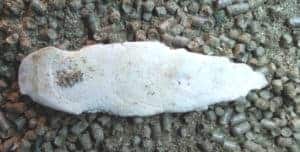
Though there are many sources of calcium available, both from foods and supplements, it remains a concern among many a tortoise owner that their pet isn’t taking on enough of this essential mineral. Calcium is required for a healthy skeleton and shell, and without it your tortoise can find themselves suffering from a plethora of health issues.
A cuttlefish bone or ‘cuttlebone’ is one of the best sources of calcium you can choose because it is completely natural. Unlike some commercially made products that contain other ingredients, cuttlebone is made from Aragonite, which is a crystalline form of pure calcium carbonate. It is widely accepted that calcium ingested in this pure form is one of the safest and healthiest ways a tortoise can ingest and metabolise it. As an added bonus, the hard form of cuttlebone naturally keeps a tortoise’s ‘beak’ trimmed, saving the need for veterinary intervention to periodically trim it.
2. Tortoise Block
For a great source of calcium in addition to other nutrients, a man made product known as ‘tortoise block’ is the answer. Essentially a block of calcium carbonate infused with dry plant and vegetable matter, a tortoise block is in theory a great supplement for your tortoise. It should be noted that, for whatever reason, not all tortoises seem to be interested in tortoise block, whereas they may have no issue with cuttlebone.
There is a certain school of thought that suggests the combination of nutrients found in tortoise block products can actually cause more harm than good, however the evidence for this is sketchy at best. For my money, so long as the additional ingredients are indeed natural and plant based, then there should be no distinction between using a cuttlebone in combination with raw vegetables with using a tortoise block.
Just like cuttlebone, tortoise block also provides the tortoise a hard and abrasive surface to chew in order to keep their beak short.
3. Thermometer
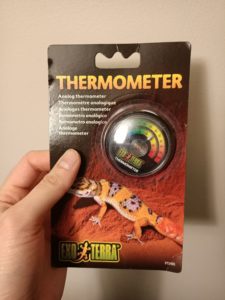
Tortoises are cold blooded animals, therefore monitoring their night and daytime environmental temperature is vital, at least when they are still a hatchling/juvenile. The thermometer you choose doesn’t need to be particularly fancy; a simple analogue gauge is more than good enough so long as it gives you an accurate reading. I use the Exo Terra PT2465 Dial Thermometer, which does the job nicely, and retails for under 5 bucks. Definitely recommended.
Besides the basic analogue type, there are a range of digital thermometers available if you fancy going high tech. These offer the advantage of giving an exact figure, rather than having to interpret a gauge, and many also provide a humidity reading as well. This is more important for tropical tortoises who require a greater level of humidity than Mediterranean or north American tortoises.
The most up to date development in the world of reptile temperature monitoring comes in the form of wireless thermometers that relay data back to your smart phone via a specially developed app. I haven’t used such a product myself, but if you have the need to remotely monitor your tortoise enclosure temperature (if you are running a semi-professional breeding operation for example) then you may have a good case for using one.
4. A Quiet Room in Your Home or Quiet Space in The Yard
Okay so this one isn’t so much a physical item, rather more of a location, but regardless it is one of the most important items on this list. A quiet living space is essential for the health of a tortoise as they can easily be overwhelmed and distressed by a lot of noise and commotion. As far as they are concerned such commotion is actually the presence of a predator, which as you can probably imagine, doesn’t make for a particularly pleasant existence.
Therefore if you keep your tortoise indoors you should aim to keep them in the quietest room in the house. Don’t opt for an area with a lot of heavy footfall and through traffic such as the living room, but instead choose somewhere like a spare bedroom that doesn’t see a lot in the way of people coming and going. This is especially critical if you live in a small apartment.
Outdoors Is a slightly different story of course, as it’s much harder to have any kind of control over background noise such as the barking of a neighbour’s dog of the clattering of rainfall. However the advantage of an outdoor enclosure should be that it is large enough for the tortoise to retreat to different areas/tunnels. With any luck this will enable them to feel as safe as they need to, but always consider making any adjustments you feel are necessary if you suspect your tortoise is unduly distressed.
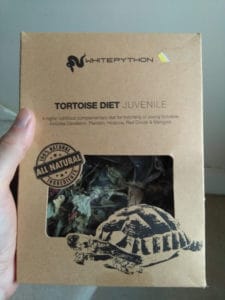
5. Dry Food Mix
I like to keep a box of dry food in the cupboard, both because it serves as a bit of variety and as an emergency backup for when you’re all out of anything else it can prove invaluable. Most dry food mixes are pretty good, including a variety of dry leaves and flowers, although you might find (as I have) that your tortoise isn’t particularly keen on eating them, but again, as a temporary last resort there is certainly no harm in trying.
6. Sufficiently Deep Substrate
One mistake a lot of people make is to not provide enough substrate for their tortoise to burrow into. This is a problem because burrowing is a big part of a tortoises natural behaviour, and although in your captivity there is no risk (in theory!) of a predatory attack, your tortoise will still get distressed if they feel they are unable to adequately retreat away from the outside world. Similarly, tortoises often burrow in order to create a nest, so if for any reason you own a pregnant female, she too will become distressed if she is unable to build her nest as she wishes.
In answer to the question, ‘how much substrate should you provide?’ the answer is enough for your tortoise to burrow and create tunnels that are able to stay intact.
7. Basking Platform
This one isn’t strictly necessary if you have your enclosure properly set up, but the general idea here is that a basking platform offers an elevated space for your tortoise to soak up heat from your heat lamp/heat emitter. As I say, not strictly necessary, especially if you can vary the height of your heat source, but besides being a functional piece, a basking platform also adds interest to your tortoise enclosure for both them and you.
There are many different options available on the market, with not much to choose between them besides aesthetics. Just ensure that whichever you choose is easy for your tortoise to climb (ie. The ramp or steps are not too steep), and that you’re happy the height of it isn’t too great, because bear in mind that tortoises are not intelligent enough not to walk off the edge! Whilst this will unlikely ever be high enough to be dangerous, it could see your tortoise end up on their back more often, which is best avoided if possible.
If you can find (or make) one with side walls that are too steep for the tortoise to climb, that will offer the best solution possible.
8. Books And Magazines on Tortoise Husbandry
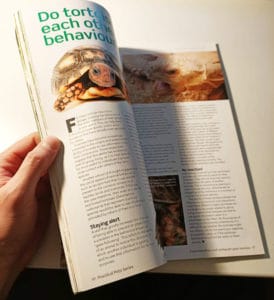
Knowledge is power right?! The internet is great and all, but there’s nothing like having a trusty source of information on your shelf that you can refer to again and again, or else read and digest at your leisure. I’ve got two or three books that I’ve picked up over the years, and all are useful in their own way. You’ll find that opinions differ on many things from one author to the next, but that’s okay, much of tortoise husbandry isn’t an exact science, and you should always discuss critical matters with a vet anyway.
More often than not books provide a sound refresher for things you already know, but are just a little rusty on, such as the procedure for hibernation or whether or not a certain plant is edible or not.
9. Enclosure Background Image
Whilst your tortoise will never feel completely at home in your care, especially if you keep them in an indoor enclosure, you can at least make it as homely as possible with the aid of a backdrop that resembles their natural habitat. There are commercially available plastic ‘posters’ that enable you to do this with ease. For example, because I own a Hermann’s tortoise, I have a backdrop image that resembles a semi-arid, dusty, rocky wilderness, much like the dry countryside of the Mediterranean.
Of course who can really say what your tortoise’s response will be to such a backdrop? They might be positively stimulated by it, or it might not make a blind bit of difference (quite literally given that tortoises have poor eyesight). However it certainly doesn’t hurt, and at the very least makes the enclosure look more interesting for you
10. Scenery Items
Tortoises aren’t terribly intelligent creatures, but they still need stimulation besides just eating and walking around aimlessly. A few well-placed items of interest will give your tortoise something else to engage with, so it’s certainly worth spending a bit of time and money fitting out your enclosure with scenery. It’s important not to go overboard however, and you especially don’t want to impede your tortoise’s chances of getting some decent exercise each day, therefore don’t allow such accessories to be so abundant as to become clutter.
Examples of objects you can use include:
· Fir cones
· Driftwood
· Commercially made ceramic ornaments
· Edible spineless cacti and succulents
· Other edible plants
· Stones/rocks
Whatever you choose you should ensure that the object is clean and sterile, particularly if it is something you have picked up from the ground, and that there is no other potential safety risk.
11. Heat Mat
A heat mat isn’t strictly necessary as long as you use a heat bulb or ceramic heat emitter, however there are times when they are of benefit, you just need to be a bit careful about how you use them. In general heat mats are designed to provide a degree of background heat, rather than the more intense, localised heat of other methods. If you’re going to fit one I would stick with fitting it to the wall of the vivarium or tortoise table, and always ensure it is used in combination with a thermostat, as heat mats are known to get dangerously hot in the absence of one.
I have only ever used a heat mat to raise the ambient night time temperature just enough to bring it up to room temperature during the winter months if over wintering my tortoise.
12. Live Moss
Tortoises require a certain amount of humidity, however, with the exception of tropical tortoises this doesn’t need to a great deal at all. For a Mediterranean tortoise a gentle misting with a spray bottle a few times a week is all that is required. An alternative to this approach is to place a bit of live moss in the tortoise enclosure. You probably could scrape moss off of a tree in your back yard, but for peace of mind I would probably stick with a commercially available product, just to be sure it will be safe for your tort.
Using live moss simply involves grabbing a handful of the stuff, soaking it in water, wringing out the excess and dumping it wherever the feel most appropriate in your tortoise enclosure. To my mind it makes most sense to place it in the hide area as it will closely simulate the humid microclimate found in the underground cavities that tortoises dig in the wild.
13. Spray Bottle
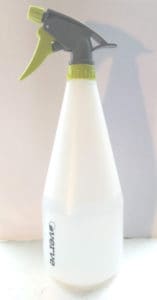
If live moss seems like a step too far, then you can always provide much needed humidity with a good old fashioned spray bottle. This doesn’t need to be anything special, just the sort of thing designed for cleaning products/pesticide that you can find in a hardware store or garden center for a few bucks/pounds with do the job.
I like to give my tortoise a quick misting once a day, just enough to provide some additional hydration to his food, and to a lesser extent a to his shell and skin.
14. Poop Scoop
Tortoises don’t poop all that often in the grand scheme of things, but when they do it’s still important to clear up after them, especially in an indoor enclosure.
I’ve found a simple and effective tool for helping to dispose of tortoise turd effectively is to have some kind of scoop on standby specifically for the job. Once again this doesn’t need to be anything special, I use a plastic gardening trowel, but you could use a candy scoop or even a spoon.
Just make sure you don’t confuse it with anything from your jar of cooking utensils.



